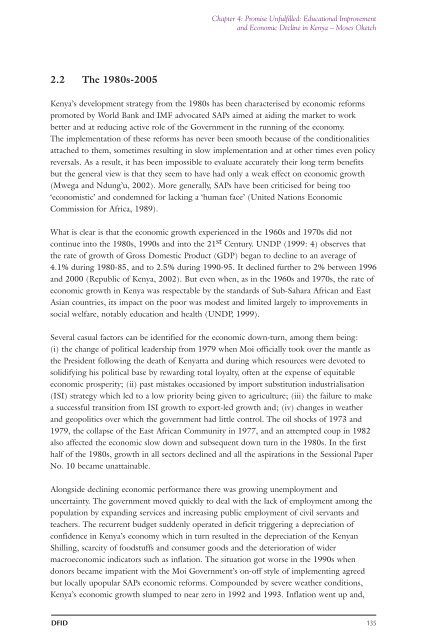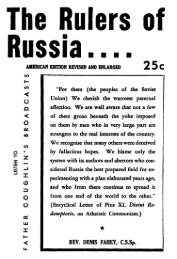education-dev-global-era-69
education-dev-global-era-69
education-dev-global-era-69
You also want an ePaper? Increase the reach of your titles
YUMPU automatically turns print PDFs into web optimized ePapers that Google loves.
Chapter 4: Promise Unfulfilled: Educational Improvementand Economic Decline in Kenya – Moses Oketch2.2 The 1980s-2005Kenya’s <strong>dev</strong>elopment strategy from the 1980s has been characterised by economic reformspromoted by World Bank and IMF advocated SAPs aimed at aiding the market to workbetter and at reducing active role of the Government in the running of the economy.The implementation of these reforms has never been smooth because of the conditionalitiesattached to them, sometimes resulting in slow implementation and at other times even policyreversals. As a result, it has been impossible to evaluate accurately their long term benefitsbut the gen<strong>era</strong>l view is that they seem to have had only a weak effect on economic growth(Mwega and Ndung’u, 2002). More gen<strong>era</strong>lly, SAPs have been criticised for being too‘economistic’ and condemned for lacking a ‘human face’ (United Nations EconomicCommission for Africa, 1989).What is clear is that the economic growth experienced in the 1960s and 1970s did notcontinue into the 1980s, 1990s and into the 21 st Century. UNDP (1999: 4) observes thatthe rate of growth of Gross Domestic Product (GDP) began to decline to an av<strong>era</strong>ge of4.1% during 1980-85, and to 2.5% during 1990-95. It declined further to 2% between 1996and 2000 (Republic of Kenya, 2002). But even when, as in the 1960s and 1970s, the rate ofeconomic growth in Kenya was respectable by the standards of Sub-Sahara African and EastAsian countries, its impact on the poor was modest and limited largely to improvements insocial welfare, notably <strong>education</strong> and health (UNDP, 1999).Sev<strong>era</strong>l casual factors can be identified for the economic down-turn, among them being:(i) the change of political leadership from 1979 when Moi officially took over the mantle asthe President following the death of Kenyatta and during which resources were <strong>dev</strong>oted tosolidifying his political base by rewarding total loyalty, often at the expense of equitableeconomic prosperity; (ii) past mistakes occasioned by import substitution industrialisation(ISI) strategy which led to a low priority being given to agriculture; (iii) the failure to makea successful transition from ISI growth to export-led growth and; (iv) changes in weath<strong>era</strong>nd geopolitics over which the government had little control. The oil shocks of 1973 and1979, the collapse of the East African Community in 1977, and an attempted coup in 1982also affected the economic slow down and subsequent down turn in the 1980s. In the firsthalf of the 1980s, growth in all sectors declined and all the aspirations in the Sessional PaperNo. 10 became unattainable.Alongside declining economic performance there was growing unemployment anduncertainty. The government moved quickly to deal with the lack of employment among thepopulation by expanding services and increasing public employment of civil servants andteachers. The recurrent budget suddenly op<strong>era</strong>ted in deficit triggering a depreciation ofconfidence in Kenya’s economy which in turn resulted in the depreciation of the KenyanShilling, scarcity of foodstuffs and consumer goods and the deterioration of widermacroeconomic indicators such as inflation. The situation got worse in the 1990s whendonors became impatient with the Moi Government’s on-off style of implementing agreedbut locally upopular SAPs economic reforms. Compounded by severe weather conditions,Kenya’s economic growth slumped to near zero in 1992 and 1993. Inflation went up and,DFID 135





